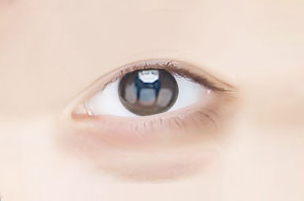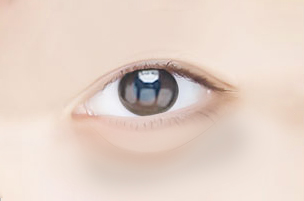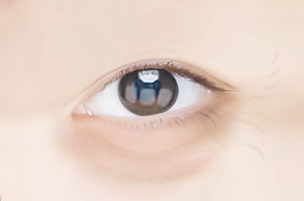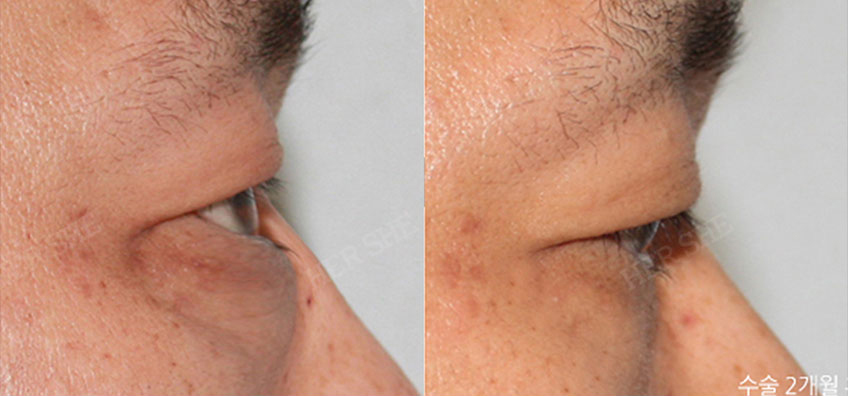- EYE BAG REMOVAL
- HERSHE
- Since 1992, HERSHE has continuously strived to research and enhance your youth and beauty
-
Discover the Vibrance of
Healthy Under-Eye Beauty. -
HER
SHE
-
Eye Bag Removal
A surgical procedure that addresses the bulging fat under the eyes can help reduce wrinkles and shadows, making a person appear older and more tired.
During lower eyelid fat repositioning, the bulging fat pads beneath the eyes are removed through the conjunctiva, located below the lower eyelid.
Some of this fat is then strategically repositioned to fill in the hollow areas under the eyes, resulting in a smoother and flatter lower eyelid contour. -
- Surgery time
1 ~ 1.5 hours - Pain Level
Low - Recovery Period
Around 1 week - Anesthetic Method
Sedation - Duration
Permanent
May vary by individual
The actual procedure and outcome of the surgery may vary depending on the individual. Side effects such as hematoma, edema, and infection may occur. - Surgery time
- Who Needs Eye Bag Removal
-
If there is an excess of fat or a sunken area under the eyes, it can lead to a bulging appearance, as well as the development of wrinkles and dark circles, making a person look older.
Lower eyelid fat repositioning is a surgical procedure that involves removing excess fat and repositioning some of the orbital fat to the sunken areas, creating a more uniform volume under the eyes.
Since each person's aging condition is unique, it is important to determine the appropriate surgical method based on an expert's diagnosis.
If there are symptoms of sagging eyelids due to aging, concurrent lower blepharoplasty may also be performed.
-
 For Bulging Fat Under the EyesWhen there is bulging fat under the eyes, a surgical procedure can be performed to remove excess orbital fat through the conjunctiva. In some cases, fat can also be repositioned or transplanted to create a flatter appearance.
For Bulging Fat Under the EyesWhen there is bulging fat under the eyes, a surgical procedure can be performed to remove excess orbital fat through the conjunctiva. In some cases, fat can also be repositioned or transplanted to create a flatter appearance. -
 For Sunken Under-Eye HollowsIf there is bulging fat under the eyes and the tear trough area below appears relatively sunken and shadowed, removing the under-eye fat while transferring some fat to the sunken area can create a flatter under-eye contour.
For Sunken Under-Eye HollowsIf there is bulging fat under the eyes and the tear trough area below appears relatively sunken and shadowed, removing the under-eye fat while transferring some fat to the sunken area can create a flatter under-eye contour. -
 For Sagging Lower Eyelids and FatIf the lower eyelids have sagged due to aging and a lack of elasticity, they can be corrected through lower eyelid surgery (lower blepharoplasty).
For Sagging Lower Eyelids and FatIf the lower eyelids have sagged due to aging and a lack of elasticity, they can be corrected through lower eyelid surgery (lower blepharoplasty).
If there is bulging fat under the eyes, combining lower eyelid fat repositioning or fat grafting can comprehensively improve the aging appearance of the under-eye area.
-


-
- When Aging Strikes: The Sudden Shift in Under-Eye Appearance
-
Genetic factors, lack of sleep, stress, and exposure to UV rays can all contribute to the symptoms of aging over time. The area under the eyes, in particular, exhibits multiple signs of aging, which can make a person appear older.
Common signs of aging under the eyes include decreased skin elasticity, wrinkles, under-eye bags, fat loss, hyperpigmentation, dark circles, and drooping lower eyelids.
Since these symptoms are often difficult to improve naturally, it is important to focus on prevention through skincare and UV protection to maintain a more youthful appearance.
In cases where more significant improvement is needed, consulting with a professional is advisable to obtain a proper diagnosis and recommend suitable surgical or non-surgical treatment options.
-

-
- Under-Eye Fat Repositioning: A Solution for Multiple Signs of Aging
-
In cases of under-eye aging, an imbalance in fat distribution can make the area appear more pronounced. Excessive bulging of under-eye fat can compromise blood flow in the infraorbital region, leading to a darker appearance. Additionally, bulging under-eye fat can create shadows that contribute to the look of severe dark circles.
Moreover, the tear trough, which extends from the inner corner of the eye downward, forms a border between areas of excess and insufficient fat. Along this border, under-eye fat appears more pronounced, while the area along the tear trough may appear hollow and shadowed.
Under-eye fat repositioning aims to remove excessive bulging fat from under the eyes and redistribute it to the hollowed areas, creating a smoother and flatter contour.
During the surgery, a certain amount of fat is removed through the conjunctiva on the lower eyelid. If necessary, the ligament supporting the fat pad beneath the front of the eye is released to allow for the repositioning of the fat pad downward. In cases where there is insufficient fat in the infraorbital region, under-eye fat grafting may be performed simultaneously.
Furthermore, to prevent the recurrence of bulging under-eye fat after surgery, measures may be taken to reinforce the laxity of the orbital septum and prevent it from loosening.
-
WHY
HERSHE -
In-Depth Assessment,
Precision Repositioning,
Personalized Care
 Septum Strengthening and Under-Eye Fat Repositioning
Septum Strengthening and Under-Eye Fat Repositioning-
Most cases of under-eye fat protrusion are attributed to laxity in the orbital septum or a narrow tear trough, which prevents even distribution of fat.
Neglecting this issue can lead to a recurrence of the problem after surgery. Therefore, during the fat repositioning process, it is crucial to ensure good vascularization and evenly distribute the fat tissue while reinforcing the orbital septum using surrounding supportive structures.
The surgical procedure begins with an incision on the inner conjunctiva of the eye to remove excessive fat. Some of the fat is then repositioned below the ligament of the tear trough to correct the hollowed appearance.
The procedure concludes with reinforcement of the orbital septum to prevent recurrence.
The incision marks are minimal and not visible externally, allowing for easy daily activities and a faster recovery. This surgery requires a thorough understanding of the anatomical structures beneath the eyes and experience with various surgical techniques. - How HERSHE Performs Eye Bag Removal Surgery
-
 Diagnosis of the Eye Condition
Diagnosis of the Eye Condition
A diagnosis is made based on the range and shape of the protruding under-eye fat, the condition of the muscles, and skin elasticity, which helps determine the appropriate surgical approach. -
 Incision on the Inner Conjunctiva Using TCA
Incision on the Inner Conjunctiva Using TCA
A precise incision is made on the inner conjunctiva of the eye using a Bovie cautery for enhanced control and accuracy. -
 Fat Removal and Repositioning
Fat Removal and Repositioning
Excess fat is removed, and if necessary, the ligament of the tear trough is released to reposition the fat downward. The orbital septum is reinforced using supportive structures to prevent the recurrence of fat protrusion. -
 Recovery After Surgery
Recovery After Surgery
The incision marks are not visible externally, allowing for a smooth resumption of daily activities such as washing, applying makeup, and socializing.
 Diagnose the Eye Condition Thoroughly Before Surgery
Diagnose the Eye Condition Thoroughly Before Surgery -
A thorough diagnosis of the eye condition is essential before considering under-eye fat repositioning surgery.
During a consultation with a specialist, a comprehensive evaluation is conducted, taking into account individual factors such as facial shape, skin elasticity around the eyes, the quantity and location of under-eye fat, and the condition of surrounding muscles.
Additionally, aesthetic considerations are taken into account to ensure natural, youthful, and beautiful results.
- Under-Eye Fat
Degree of fat protrusion, Sagging, Distribution of orbital fat - Under-Eye Skin
Sagging of eyelids, Skin laxity, Under-eye wrinkles, Skin thickness - Tear Trough
Distribution of fat, Level of shadowing, Range and depth of tear trough
 Dedicated Medical Team for Eye Plastic Surgery with Personalized 1:1 Care
Dedicated Medical Team for Eye Plastic Surgery with Personalized 1:1 Care-
The eyes are the most prominent features of a person's face and significantly impact overall impression. They are often the first body part noticed, and their shape and size play a crucial role in influencing how others perceive us.
Double eyelid surgery can enhance the shape and size of the eyes, as the double eyelid line itself carries aesthetic significance. This procedure is widely sought after for its ability to transform one’s appearance. Therefore, it is essential for a surgeon specializing in double eyelid surgery to have a comprehensive understanding of the eyelids, surrounding structures, and the potential risks and complications associated with the procedure.
Effective communication is also paramount; surgeons should provide honest and realistic feedback regarding the achievable outcomes of surgery.
Therefore, a surgeon specializing in double eyelid surgery should have a thorough understanding of the eyelids, surrounding structures, and potential risks and complications associated with the procedure.
Additionally, they should prioritize effective communication with the patient and provide honest and realistic feedback regarding the achievable range of improvements through surgery.
At HERSHE Plastic Surgery, our dedicated team of eye surgery specialists brings extensive surgical experience and expertise. We conduct thorough diagnoses and consultations, considering factors such as eyelid thickness, skin condition, eye shape and size, and desired outcomes to determine the most suitable surgical approach.
We offer personalized, one-on-one care from surgery through recovery, ensuring the best possible results for our patients.

- HER
-
Your Eyes,
Your Signature - SHE

- Professional
- A dedicated plastic surgeon specializing in under-eye procedures offers personalized consultations, performs surgeries, and manages post-operative care.
-
While considering factors such as your current age, under-eye skin condition, and amount of fat, we help you choose the most suitable procedure.
We offer individualized under-eye treatments tailored specifically to you, rather than following a fixed plan.
- FAQ
- Frequently Asked Questions
Q.Is Under-Eye Fat Repositioning Different From Under-Eye Liposuction?
A. From a broader perspective, both surgeries aim to address the imbalance in the distribution of under-eye orbital fat. The difference lies in the fact that under-eye fat repositioning involves not only the removal of excessive orbital fat but also the redistribution of some fat to the hollowed areas along the tear trough. Since the incision site for both procedures is the same, they can be selectively performed if deemed necessary during the diagnosis.
Q.Will There Be Noticeable Scarring?
A. The incision is made on the inside of the lower eyelid, resulting in no visible scar left after the surgery. However, when aging symptoms are severe and a simultaneous surgery is performed with lower blepharoplasty to remove drooping skin, a scar may be visible over time, as the incision is made externally.
Q.Are There Any Side Effects?
A. All surgeries carry the potential for unexpected discomfort or side effects. To minimize these risks, it is essential to consult with experienced specialists and carefully follow post-surgery care instructions. If you experience significant discomfort, severe bleeding, heat sensation, inflammation, or any other concerning symptoms, it is important to promptly contact the clinic for appropriate care.
Q.Will It Be Painful?
A.Post-surgery pain is typically mild, but some discomfort may occur as the anesthesia wears off. Diligently following post-surgery instructions and guidelines, along with taking all prescribed medications from the clinic, can help prevent inflammation and alleviate pain.
Q.When Can I Return to Daily Activities?
A. Aside from the surgical mark being noticeable and slightly uncomfortable, the typical recovery period for bruising and swelling is around 2 to 3 weeks. After this period, you can resume daily activities such as applying eye makeup and wearing contact lenses. Over the following 3 to 6 months, the tissues affected by the surgery will gradually heal, resulting in a natural outcome. By following the post-surgery instructions provided by the hospital, you can expect a faster recovery and more stable surgical results.
Q.What Are the Post-Surgery Precautions?
A. Prior to the surgery, the clinic will provide you with explanations, consent forms, and pre-surgery instructions. After the surgery, the clinic will provide post-surgery instructions as well as prescribed medication. Some important post-surgery instructions include abstaining from alcohol and smoking for about a month to prevent bleeding and infection. If you experience itching, swelling, or allergic reactions around the eyes while taking antibiotics after the surgery, discontinue the medication and visit the clinic. It is advisable to avoid getting water on or around the eyes for about a week. To reduce bruising, swelling, and bleeding, cold compresses can be applied for approximately 2 to 3 days after the surgery, followed by a combination of warm and cold compresses after one week, along with light walking. It is important to avoid positions that increase blood pressure around the eye area, such as bending over.
It is important to avoid positions that increase blood pressure around the eye area, such as bending over.
-
HER
SHE -
As time flows,
keep your eyes bright and youthful!
HERSHE Plastic Surgery is
your perfect choice for eye aesthetics.


- 허쉬성형외과 전문의 의료진이 콕콕 짚어드립니다.
-

 힙업리프팅으로 애플힙 뒤태 만들수있나요? 힙업성형 Q&A
힙업리프팅으로 애플힙 뒤태 만들수있나요? 힙업성형 Q&A
-

 어깨필러 상담부터 시술과정까지, 직각어깨 REAL 현장
어깨필러 상담부터 시술과정까지, 직각어깨 REAL 현장

 쌍수하고 술 언제부터 마셔도 되나요?
쌍수하고 술 언제부터 마셔도 되나요?

- Before After
- 만족스러운 Eye bag removal 다음은 당신입니다.



-
1
허쉬는 대리수술이 없습니다.
진료를 담당한 의사가 직접 수술하는 것은 당연합니다. -
2
무리한 수술을 권유하지 않습니다.
디테일한 상담, 명확한 진단으로 가능한 범위 내에서
진료를 하겠습니다. -
3
끊임없는 연구와 노력을 이어갑니다.
기본부터 지키며, 성형을 발전시키는데
이바지하겠습니다. -
4
환자와 공감하고 소통하는 병원
작은 목소리도 가족이나 친구처럼 소홀히 하지 않습니다.


































